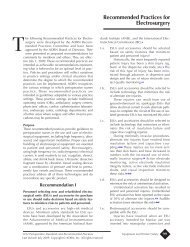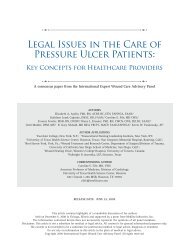2009 CAUTI guidelines - Centers for Disease Control and Prevention
2009 CAUTI guidelines - Centers for Disease Control and Prevention
2009 CAUTI guidelines - Centers for Disease Control and Prevention
Create successful ePaper yourself
Turn your PDF publications into a flip-book with our unique Google optimized e-Paper software.
For all comparisons, we considered <strong>CAUTI</strong> outcomes as well as other outcomes critical toweighing the risks <strong>and</strong> benefits of different catheter management techniques. The evidence <strong>for</strong>this question consists of 6 systematic reviews, 37,105,106,182-184 56 RCTs, 60,61,65-69,143,158,158,185-231 34observational studies, 83,85,88,90,96,102,133,167,178,232-258 <strong>and</strong> 1 economic analysis. 180 The findings of theevidence review <strong>and</strong> the grades <strong>for</strong> all important outcomes are shown in Evidence ReviewTable 2C.Q2C.1. Antimicrobial prophylaxisLow-quality evidence suggested no benefit of antimicrobial prophylaxis in patients undergoingshort-term catheterization. 37,60,61,83,85,133,158,178,182,185,186,189-191,232-234 This was based onheterogeneous results <strong>for</strong> SUTI <strong>and</strong> bacteriuria/unspecified UTI <strong>and</strong> no adverse events relatedto antimicrobials. Lack of consistency in specific factors, such as patient population,antimicrobial agents, timing of administration, <strong>and</strong> duration of follow-up, did not allow <strong>for</strong> asummary of evidence of the effect of antimicrobial prophylaxis on <strong>CAUTI</strong> in patients undergoingshort term catheterization. Only two studies evaluated adverse events related to antimicrobials.Our search did not reveal data on antimicrobial resistance or Clostridium difficile infection.Low-quality evidence suggested no benefit of antimicrobial prophylaxis in patients undergoinglong-term catheterization (indwelling <strong>and</strong> clean intermittent catheterization). 106,183,192,194,235,238This was based on a decreased risk of bacteriuria, heterogeneous results <strong>for</strong> SUTI, <strong>and</strong> nodifferences reported <strong>for</strong> catheter encrustation or adverse events, although data were sparse.One systematic review suggested an increase in antimicrobial resistance with antimicrobial use.Q2C.2. Urinary antisepticsLow-quality evidence suggested a benefit of methenamine <strong>for</strong> short-term catheterizedpatients. 196,197 This was based on a reduced risk of SUTI <strong>and</strong> bacteriuria <strong>and</strong> no differences inadverse events. Evidence was limited to two studies of patients following gynecological surgeryin Norway <strong>and</strong> Sweden.Very low-quality evidence suggested a benefit of methanamine <strong>for</strong> long-term catheterizedpatients. 106,236-239 This was based on a reduced risk of encrustation but no differences in risk ofSUTI or bacteriuria. Data on encrustation was limited to one study. Studies involved primarilyelderly <strong>and</strong> spinal cord injury patients with chronic indwelling cathetersQ2C.3. Bladder irrigationLow-quality evidence suggested no benefit of bladder irrigation in patients with indwelling orintermittent catheters. 66,69,199-206,240-242 This was based on no differences in SUTI <strong>and</strong>heterogeneous findings <strong>for</strong> bacteriuria.Q2C.4. Antiseptic instillation in the drainage bagLow-quality evidence suggested no benefit of antiseptic instillation in urinary drainagebags. 90,207-211,243-245 This was based on no differences in SUTI <strong>and</strong> heterogeneous results <strong>for</strong>bacteriuria.Q2C.5. Periurethral care42
















